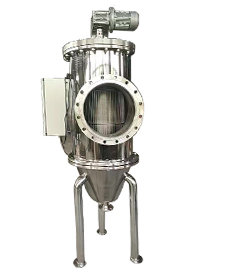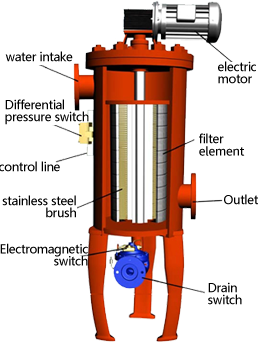In the world of fluid processing and filtration, the need for efficient and reliable solutions is ever-present. Self-cleaning filters have emerged as a game-changing technology, revolutionizing the way we maintain the purity of fluids in a wide range of applications. These filters are designed to continuously operate while automatically cleaning themselves, ensuring uninterrupted filtration and optimal performance.

Self-cleaning filters are the result of advanced engineering and technological innovation. They combine the principles of filtration with automated cleaning mechanisms to provide a seamless solution for handling contaminated fluids. The development of these filters was driven by the need to overcome the limitations of traditional filters, which required frequent manual cleaning and replacement, leading to downtime and increased maintenance costs.
The filtration process in a self-cleaning filter begins with the fluid entering the filter housing. The filter element, which is typically made of a porous material such as stainless steel mesh or synthetic fabric, allows the clean fluid to pass through while trapping the contaminants. The size and nature of the filter element are designed to capture particles of a specific range, depending on the application requirements. For example, in water treatment, the filter may be designed to remove sediments, bacteria, and other impurities, while in industrial processes, it may be used to filter out fine particles that could damage equipment.
The self-cleaning feature is the key differentiator of these filters. There are several methods by which the self-cleaning occurs. One common method is backwashing. When the pressure drop across the filter reaches a certain threshold or after a pre-set time interval, the flow direction is reversed. The clean fluid on the downstream side is pumped back through the filter element in the opposite direction, dislodging the accumulated contaminants and flushing them out through a dedicated outlet. Another method is the use of mechanical scrapers or brushes. These are attached to a rotating or oscillating mechanism that moves across the surface of the filter element, physically removing the contaminants. Some advanced self-cleaning filters may also utilize ultrasonic or pulsed air technologies to enhance the cleaning process. These technologies use high-frequency vibrations or bursts of air to loosen and remove the contaminants more effectively.
The filter element is the core component of the self-cleaning filter and is available in various materials and configurations. Stainless steel filter elements are known for their durability, corrosion resistance, and ability to handle high temperatures and pressures. They are suitable for harsh industrial environments and applications where long service life is required. Synthetic filter elements, on the other hand, offer excellent filtration accuracy and can be designed to capture very fine particles. They are often used in applications where high purity of the filtered fluid is crucial, such as in the electronics or pharmaceutical industries. The filter element may be in the form of a cylindrical cartridge, a flat screen, or a pleated structure, depending on the specific flow rate and filtration requirements.
The housing and frame of the self-cleaning filter provide structural support and protection to the filter element. They are usually made of robust materials such as cast iron, stainless steel, or plastic, depending on the application and the nature of the fluid being filtered. The housing is designed to withstand the pressure and flow conditions of the system and to ensure a tight seal to prevent any leakage. It also houses the mechanisms for self-cleaning, including the backwashing valves, the motors or actuators for mechanical cleaners, and any sensors or controllers that are part of the self-cleaning system.
The control system is an essential part of the self-cleaning filter, as it monitors the operation and triggers the self-cleaning process when needed. It typically consists of pressure sensors, flow meters, and a controller. The pressure sensors measure the pressure drop across the filter, and when it exceeds a pre-set value, the controller signals the start of the self-cleaning cycle. The flow meters are used to monitor the flow rate of the fluid and ensure that the filter is operating within the designed parameters. The controller may be a simple programmable logic controller (PLC) or a more advanced microprocessor-based system that can be integrated with the overall automation system of the plant. It can also provide real-time data on the filter's performance and allow for remote monitoring and control.

One of the major advantages of self-cleaning filters is their ability to provide continuous filtration without the need for frequent shutdowns for manual cleaning. This ensures uninterrupted operation of the process, reducing downtime and increasing productivity. In applications where the flow of clean fluid is critical, such as in manufacturing processes or water treatment plants, this continuous operation is essential for maintaining the efficiency and quality of the overall system.
By automating the cleaning process, self-cleaning filters significantly reduce maintenance costs and labor. Manual cleaning of traditional filters can be time-consuming and requires skilled personnel. With self-cleaning filters, the need for frequent filter replacement is also minimized, as the effective self-cleaning process extends the life of the filter element. This results in overall cost savings for the operation and maintenance of the filtration system.
Self-cleaning filters maintain a consistent level of filtration efficiency over time. As the filter element is continuously cleaned, it does not become clogged with contaminants, ensuring that the filtered fluid meets the required quality standards. This is especially important in applications where high purity of the fluid is essential, such as in the production of pharmaceuticals or electronics. The ability to maintain high filtration efficiency also helps to protect downstream equipment from damage caused by contaminants, reducing the risk of costly repairs and maintenance.
Self-cleaning filters are available in a wide range of sizes and configurations, making them suitable for various applications and industries. They can be customized to meet the specific filtration requirements of different processes, including different flow rates, particle sizes, and fluid types. Whether it is a small-scale industrial process or a large-scale water treatment plant, self-cleaning filters can be designed and installed to provide efficient filtration and self-cleaning capabilities.
In the water treatment industry, self-cleaning filters are widely used in various stages of the treatment process. They are used in pretreatment to remove large particles and sediments from raw water, in filtration systems for municipal water supply and wastewater treatment plants, and in industrial water treatment for processes such as reverse osmosis pre-filtration. Self-cleaning filters help to ensure the quality of the treated water and protect the expensive membrane filtration systems downstream.
The oil and gas industry relies on self-cleaning filters for filtration in drilling operations, production, and transportation. They are used to filter out solids and impurities from drilling mud, crude oil, and natural gas. Self-cleaning filters help to prevent clogging of pipelines, protect equipment in refineries, and ensure the quality of the final products. In offshore applications, where maintenance is more challenging and costly, the reliability and self-cleaning capabilities of these filters are especially valuable.
In manufacturing industries such as automotive, electronics, and food and beverage, self-cleaning filters are used to filter process fluids, cooling lubricants, and air. They help to maintain the quality of the products by removing contaminants that could affect the manufacturing process or the quality of the final product. For example, in the electronics industry, clean air is essential to prevent dust particles from contaminating sensitive electronic components during manufacturing. Self-cleaning filters in the air ventilation systems ensure a clean and controlled environment.
In agricultural applications, self-cleaning filters are used in irrigation systems to filter out sediments and impurities from water sources. This ensures that the water sprayed on crops is clean and free from harmful particles that could clog the irrigation nozzles or affect the growth of the plants. Self-cleaning filters also help to protect the pumps and other equipment in the irrigation system, reducing maintenance and increasing the efficiency of water distribution.
Self-cleaning filters represent a significant advancement in filtration technology. Their ability to provide continuous, efficient, and low-maintenance filtration makes them an ideal solution for a wide range of applications in various industries. As technology continues to evolve, we can expect further improvements in the design and performance of self-cleaning filters, enabling them to meet the increasingly complex filtration requirements of modern processes. Whether it is ensuring the quality of water, protecting valuable equipment in the oil and gas industry, or maintaining a clean environment in manufacturing, self-cleaning filters are playing a crucial role in enhancing the efficiency and sustainability of fluid processing operations. With their numerous benefits and wide-ranging applications, self-cleaning filters are set to continue revolutionizing the field of filtration for years to come.












